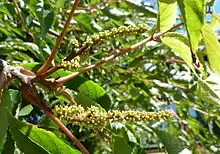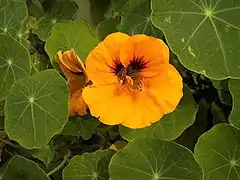
| Flowering plant families (APG IV) | |||||
|---|---|---|---|---|---|
|
|
|||||
| Early-diverging flowering plants | |||||
| Monocots: Alismatids • Commelinids • Lilioids | |||||
|
|
|||||
Eudicots
|
The malvids consist of eight orders of flowering plants: Brassicales, Crossosomatales, Geraniales, Huerteales, Malvales, Myrtales, Picramniales and Sapindales.[lower-alpha 1] This subgroup of the rosids is divided into 59 families of trees, shrubs, vines and herbaceous plants.[4][5]
The cabbage family includes broccoli, turnips and radishes.[6] The ornamental geraniums, and their many hybrids and cultivars, come from five species of Pelargonium.[7] The mallow family includes the plants that yield cocoa beans, Cola nuts, cotton and jute.[8] Pomegranates were cultivated by Bronze Age cultures, and wild water chestnuts were consumed in large quantities by prehistoric Europeans.[9] Eucalyptus trees are the tallest known flowering plants, up to 100 m (330 ft) or more; they are grown for timber and for their oils, used in candy, perfumes and cough medicine.[10] Mangos and cashews come from the same plant family as poison ivy, and can sometimes trigger allergic reactions.[11] Canada produces most of the world's maple syrup, and the maple leaf is the country's national symbol.[12] Citrus agriculture outranks other sweet-fruit industries in warm climates.[13]
Glossary
From the glossary of botanical terms:
- annual: a plant species that completes its life cycle within a single year or growing season
- basal: attached close to the base (of a plant or an evolutionary tree diagram)
- climber: a vine that leans on, twines around or clings to other plants for vertical support
- deciduous: falling seasonally, as with bark, leaves, or petals
- glandular hair: a hair tipped with a secretory structure
- herbaceous: not woody; usually green and soft in texture
- mangrove: any shrub or small tree growing in brackish or salt water
- perennial: not an annual or biennial
- succulent (adjective): juicy or fleshy
- unisexual: of one sex; bearing only male or only female reproductive organs
- woody: hard and lignified; not herbaceous[14]
The APG IV system is the fourth in a series of plant taxonomies from the Angiosperm Phylogeny Group.[2] In this system, Geraniales and Myrtales are basal within the malvids.[15]
Families
| Family and a common name[16][lower-alpha 2] | Type genus and etymology[lower-alpha 3] | Total genera; global distribution | Description and uses | Order[4] | Type genus images |
|---|---|---|---|---|---|
| Akaniaceae (turnipwood family)[18] | Akania, from Greek for "bractless", possibly[18][19] | 2 genera, in the Himalayas, China, Southeast Asia and Australia[20] | Trees with a mustard scent in the bark and flowers[18] | Brassicales | |
| Alzateaceae (wantsum family)[21] | Alzatea, for José Antonio de Alzate y Ramírez (d. 1795), a cartographer[21] | 1 genus, in South America[22] | Short evergreen trees and shrubs with four-sided stems[21][23] | Myrtales | |
| Anacardiaceae (cashew family)[24] | Anacardium, from a Greek plant name[24][25] | 79 genera, mostly in the tropics, with some temperate species[26][27] | Shrubs, trees and vines, generally with sap that can turn black. Cashews and mangos are commercially important tropical crops.[24][28] | Sapindales | |
| Aphloiaceae (mountain-peach family)[29] | Aphloia, from Greek for "unbarked"[29] | 1 genus, in Africa and on islands of the Indian Ocean[30] | Evergreen shrubs and small trees[29] | Crossosomatales | |
| Bataceae (turtleweed family)[31] | Batis, from Greek for "walking"[32] | 1 genus, in New Guinea, Australia, and the tropics and subtropics of the Americas[33] | Short, succulent viny shrubs with unisexual flowers[23][31] | Brassicales | |
| Biebersteiniaceae (khardug family)[34] | Biebersteinia, for Friedrich August Marschall von Bieberstein (1768–1826)[34] | 1 genus, in Eurasia[35] | Foul-smelling herbaceous perennials with woody rhizomes[34] | Sapindales | — |
| Bixaceae (annatto family)[36] | Bixa, from a Carib plant name[36][37][38] | 3 genera, in the Americas and Madagascar[39] | Shrubs, trees and herbaceous perennials. Bixa orellana yields annatto, a widely used red food dye.[28][36] | Malvales | |
| Brassicaceae (cabbage family)[6] | Brassica, from a Latin plant name[40][41][42] | 344 genera, scattered around the world, especially in the Northern Hemisphere[43][44] | Shrubs and herbaceous plants, with a few vines and small trees and a few species that grow in water. The cabbage family includes broccoli, cauliflower, turnips, watercress, radishes and horseradish, along with the plants that yield canola oil and the mustards.[6][23] | Brassicales | |
| Burseraceae (frankincense-and-myrrh family)[45] | Bursera, for Joachim Burser (1583–1639)[45][46] | 18 genera, in the tropics[26][47] | Generally unisexual shrubs and trees, with some climbers and some species that grow on other plants. Most species, especially in the frankincense and myrrh genera, are heavily scented.[23][45] | Sapindales | |
| Capparaceae (caper family)[48] | Capparis, from a Greek plant name[49][50] | 15 genera, around the world[43][51] | Shrubs and trees, with up to 250 stamens per flower. Capers (the preserved flower buds of Capparis) are usually harvested in the wild rather than cultivated.[48][52] | Brassicales | |
| Caricaceae (papaya family)[53] | Carica, from a Latin plant name[54][55] | 6 genera, in West Africa and the tropics of the Americas[43][56] | Shrubs and trees, usually unisexual and spiny, with a few vines. Papaya fruit was already in cultivation in Central America before 1500.[28][53] | Brassicales | |
| Cistaceae (rock-rose family)[57] | Cistus, from a Greek plant name[58][59][60] | 8 genera, mainly in warmer parts of the Northern Hemisphere[61][62] | Shrubs and herbaceous plants, frequently with volatile oils, with a few tall tree species. Labdanum (from Cistus) is used in perfumes.[23][57] | Malvales |  Cistus monpeliensis |
| Cleomaceae (spiderflower family)[63] | Cleome, from Greek for "glory"[63][64][65] | 2 genera, in the subtropics, the tropics, and North America[66] | Shrubs and herbaceous plants. The leaves are consumed in South Africa.[23][63] | Brassicales | |
| Combretaceae (bushwillow family)[67] | Combretum, from a Latin plant name[68][69] | 10 genera, in the tropics[70][71] | Shrubs, trees and woody vines, along with a few mangroves[52][67] | Myrtales | |
| Crossosomataceae (rockflower family)[72] | Crossosoma, from Greek for "fringed body" (of the seeds)[72][73] | 4 genera, in the US and northeastern Mexico[74] | Shrubs, often with small leaves, and a few trees[72] | Crossosomatales | |
| Crypteroniaceae (bekoi family)[75] | Crypteronia, from Greek for "hidden love" (for the small flowers)[75][76] | 3 genera, in the Asian tropics[77] | Evergreen trees with tiny bisexual or unisexual flowers[75] | Myrtales | — |
| Cytinaceae (rockrose-rape family)[78] | Cytinus, from Greek for "part of a pomegranate"[78][79] | 2 genera, in Africa and nearby islands, western Asia, and Mexico to northern South America[80] | Parasitic plants without chlorophyll, usually with unisexual flowers[78] | Malvales | |
| Dipentodontaceae (shichi family)[81] | Dipentodon, from Greek for "two groups of five teeth" (on the sepals and petals)[81][82] | 2 genera, scattered around the world[81][83] | Unisexual and bisexual shrubs and trees[81] | Huerteales | — |
| Dipterocarpaceae (maranti family)[84] | Dipterocarpus, from Greek for "two-winged fruit"[84][85] | 16 genera, in South America, Africa and southern parts of Asia[61][86] | Mostly evergreen trees with scented resins. These rainforest trees were an important source of timber and camphor a century ago, but they have been depleted from overlogging.[84][87] | Malvales | |
| Emblingiaceae (slippercreeper family)[88] | Emblingia, for Thomas Embling (1814–1893)[89] | 1 genus, in Australia[90] | Herbaceous shrubs with low branches[88] | Brassicales | |
| Francoaceae (bridal-wreath family)[91] | Francoa, for Francisco Franco (c. 1515 – c. 1569), a Spanish doctor[91][92] | 6 genera, in South America and Africa[93][94] | Small trees, large shrubs and herbaceous plants, some used in herbal teas[28][91] | Geraniales | |
| Geissolomataceae (cape-cups family)[95] | Geissoloma, from Greek for "tiled fringe" (on the petals)[96] | 1 genus, in South Africa[97] | Short, many-branched shrubs that bioaccumulate aluminium[95] | Crossosomatales | |
| Geraniaceae (crane's-bill family)[7] | Geranium, from a Greek plant name meaning "crane"[98][99][100] | 8 genera,scattered around the world[93][101] | Shrubs and herbaceous plants, most of them hairy, some succulent[7][23] | Geraniales | |
| Gerrardinaceae (brown-ironwood family)[102] | Gerrardina, for William Tyrer Gerrard (c. 1831 – 1866)[103] | 1 genus, in southern Africa and Tanzania[104] | Shrubs and small trees, frequently with drooping branches[102] | Huerteales | 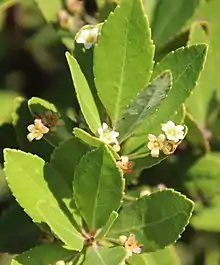 Gerrardina foliosa |
| Guamatelaceae (Guatemalan-bramble family)[105] | Guamatela, an anagram of Guatemala[105] | 1 genus, in Mexico and Central America[106] | Many-branched shrubs[105] | Crossosomatales | — |
| Gyrostemonaceae (buttoncreeper family)[107] | Gyrostemon, from Greek for "round stamens"[107][108] | 5 genera, in Australia[43][109] | Annual unisexual shrubs and small trees, frequently succulent[107] | Brassicales |  Gyrostemon ramulosis |
| Kirkiaceae (white-seringa family)[45] | Kirkia, for John Kirk (1832–1922)[110] | 1 genus, in Africa[111] | Trees and shrubs with essentially unisexual flowers. Timber from Kirkia acuminata is used for construction, furniture and tool-making.[45] | Sapindales |  Kirkia wilmsii |
| Koeberliniaceae (allthorn family)[112] | Koeberlinia, for Christoph Ludwig Köberlin (1794–1862), a German botanist and clergyman[113] | 1 genus, in the US, Mexico and Bolivia[114] | Deciduous, many-branched, thorny-tipped shrubs and small trees[23][112] | Brassicales | |
| Limnanthaceae (meadowfoam family)[115] | Limnanthes, from Greek for "marsh flowers"[116][117] | 2 genera, in North America[118] | Mustard-scented herbaceous annuals. Poached egg plant is grown as an ornamental.[115] | Brassicales | |
| Lythraceae (pomegranate family)[119] | Lythrum, from Greek for "bloody" (flowers)[120][121][122] | 28 genera, in temperate and tropical Eurasia, Africa and Oceania[70][123] | Shrubs, trees and herbaceous plants, often with square stems, with some mangroves and aquatic species[52][119] | Myrtales | |
| Malvaceae (mallow family)[8] | Malva, from a Latin plant name[124][125][126] | 245 genera, scattered worldwide[61][127] | Hairy shrubs, trees and herbaceous plants. Cocoa beans are native to tropical South and Central America, and Cola nuts are native to West Africa. The most commercially valuable genera are Gossypium (cotton) and Corchorus (jute).[8][52] | Malvales | |
| Melastomataceae (senduduk family)[128] | Melastoma, from Greek for "black mouth" (the result of eating the berries)[129][130] | 164 genera, mostly in the tropics and subtropics[70][131] | Trees, shrubs and herbaceous plants, with a few species that grow in water or on other plants[52][128] | Myrtales | |
| Meliaceae (neem family)[132] | Melia, from a Greek plant name[129][133][134] | 58 genera, in the tropics, with some temperate species[26][135] | Generally unisexual shrublets, shrubs and trees. Neem oil has many uses, including as a pesticide, and the wood is similar to mahogany.[28][132] | Sapindales | |
| Moringaceae (horseradish-tree family)[136] | Moringa, from a Tamil plant name[137] | 1 genus, in Africa, Southwest Asia and South Asia[138] | Mustard-scented shrubs and trees, with a few herbaceous plants[28][136] | Brassicales | |
| Muntingiaceae (bajelly-tree family)[139] | Muntingia, for Abraham Munting (1626–1683)[140][141] | 3 genera, from Mexico to South America[142] | Hairy shrubs and trees[23][139] | Malvales | |
| Myrtaceae (myrtle family)[143] | Myrtus, from Greek and Latin plant names[144][145][146] | 126 genera, in the tropics and warmer temperate zones[70][147] | Evergreen shrubs and trees, most with volatile oils, including Eucalyptus and the tree that produces clove spice[23][143] | Myrtales | |
| Neuradaceae (pietsnot family)[148] | Neurada, from Greek and Latin plant names[149][150] | 3 genera, in Africa and southern Asia[151] | Herbaceous plants, usually with hairy stems that hug the ground[148] | Malvales |  Neurada procumbens |
| Nitrariaceae (nitrebush family)[152] | Nitraria, from Greek for "nitre" (found near the plant)[152][153] | 4 genera, scattered around the world[154] | Shrubs and herbaceous plants, frequently succulent, that bioaccumulate salt[152] | Sapindales | |
| Onagraceae (fuchsia family)[155] | Oenothera. Onagra, an earlier synonym, is from Greek for "onager" (fodder).[155][156][157] | 22 genera, scattered worldwide[70][158] | Shrubs and a few trees and woody vines, including Fuchsia and evening primrose[52][155] | Myrtales | |
| Penaeaceae (cape-fellwort family)[159] | Penaea, for Pierre Pena (1535–1605), a French doctor and botanist[160][161] | 3 genera, from South Africa to Ethiopia[162] | Small shrubs to tall trees with buttress roots, all with four-sided new stems[87][159] | Myrtales |  Penaea mucronata |
| Pentadiplandraceae (oubli family)[163] | Pentadiplandra, from Greek for "five double male" (stamens)[163] | 1 genus, in the African tropics[164] | Just one species: a shrub with smooth stems that occasionally sprouts woody vines[28][163] | Brassicales | |
| Petenaeaceae (Petén-linden family)[165] | Petenaea, for Lake Petén Itzá[165] | 1 genus, in Mexico and Central America[166] | Large shrubs and small trees[165] | Huerteales | — |
| Picramniaceae (bitterbush family)[167] | Picramnia, from Greek for "bitter bush"[167][168] | 4 genera, in South America and southern North America[169] | Unisexual shrubs and trees with small flowers[23][167] | Picramniales | .jpg.webp) Picramnia glazioviana |
| Resedaceae (mignonette family)[170] | Reseda, from a Latin plant name[171][172] | 11 genera, around the world[43][173] | Shrubs, trees, vines and herbaceous plants. Reseda odorata (a mignonette species) is an ornamental that is also used in perfumes.[52][170] | Brassicales | |
| Rutaceae (citrus family)[174] | Ruta, from a Latin plant name[175][176] | 153 genera, in tropical and temperate zones[26][177] | Shrubs, trees and herbaceous perennials, usually scented. Citrus fruits were in cultivation in China 5000 years ago.[87][174] | Sapindales | |
| Salvadoraceae (toothbrush-tree family)[178] | Salvadora, for Jaime Salvador y Pedrol (1649–1740), a Spanish apothecary[179][180] | 3 genera, in Africa and South Asia[43][181] | Shrubs and small trees with succulent or leathery leaves[52][178] | Brassicales | |
| Sapindaceae (maple family)[182] | Sapindus, from Latin for "soap of India"[183][184] | 143 genera, in the tropics, with some temperate species[26][185] | Shrubs, trees, climbers and herbaceous perennials. Lychee and rambutan fruits are widely cultivated in Asia. The family contains many ornamental species.[87][182] | Sapindales | |
| Sarcolaenaceae (tunic-bells family)[186] | Sarcolaena, from Greek for "flesh cloak"[186][187] | 10 genera, in Madagascar[61][188] | Hairy evergreen shrubs and trees[186] | Malvales | |
| Setchellanthaceae (azulita family)[189] | Setchellanthus, for William Albert Setchell (1864–1943)[190] | 1 genus, in Mexico[191] | Hairy many-branched shrubs with succulent leaves[23][189] | Brassicales | — |
| Simaroubaceae (tree-of-heaven family)[192] | Simarouba, from a Carib plant name[192][193] | 20 genera, in the tropics, with some temperate species[194] | Shrubs and trees with bitter bark. Corkwood is lightweight, and used to make floats for fishing nets.[52][192] | Sapindales | |
| Sphaerosepalaceae (lombiry family)[195] | Rhopalocarpus. Sphaerosepalum, an earlier synonym, is from Greek for "spherical sepals".[195][196][197] | 2 genera, in Madagascar[198] | Shrubs and trees. Many of the species are threatened.[195] | Malvales | — |
| Stachyuraceae (spiketail family)[199] | Stachyurus, from Greek for "spike tail" (on the inflorescences)[200][201] | 1 genus, in East Asia and mainland Southeast Asia[202] | Unisexual and bisexual shrubs and small trees, with a few vines[199] | Crossosomatales | |
| Staphyleaceae (bladdernut family)[203] | Staphylea, from Greek for "clusters" (of flowers)[201][204][205] | 3 genera, scattered worldwide[206] | Shrubs and trees[203] | Crossosomatales | |
| Strasburgeriaceae (tawari family)[207] | Strasburgeria, for Eduard Strasburger (1844–1912)[208][209] | 2 genera, in New Caledonia and New Zealand[210] | Evergreen trees[207] | Crossosomatales | |
| Tapisciaceae (silverpheasant-tree family)[211] | Tapiscia, an anagram of the genus Pistacia[211][212] | 2 genera, in the Americas and in East and mainland Southeast Asia[213] | Trees with fluorescent wood[23][211] | Huerteales | |
| Thymelaeaceae (mezereon family)[214] | Thymelaea, from Greek for "poison olive"[214][215] | 52 genera, scattered worldwide[61][216] | Generally poisonous shrubs, small trees and herbaceous perennials, with a few vines. The bark of some species has traditionally been used to make strong, fibrous paper.[52][214] | Malvales | |
| Tovariaceae (stinkbush family)[88] | Tovaria, for Simón de Tovar, a Spanish doctor and botanist[217] | 1 genus, from Mexico to the tropics of the Americas[218] | Foul-smelling erect herbaceous perennials and floppy shrubs[23][88] | Brassicales |  Tovaria pendula |
| Tropaeolaceae (nasturtium family)[219] | Tropaeolum, from Greek for "trophy"[220][221] | 1 genus, in Mexico and Central and South America[222] | Mustard-scented herbaceous annuals and perennials, including garden nasturtium and other ornamentals[23][219] | Brassicales | |
| Vochysiaceae (quaruba family)[223] | Vochysia, from a Carib plant name[223][224] | 8 genera, mainly in the tropics of the Americas and West Africa[70][225] | Trees and shrubs that bioaccumulate aluminium[23][223] | Myrtales |  Vochysia lucida |
See also
Notes
- ↑ The taxonomy (classification) in this list follows Plants of the World (2017)[1] and the fourth Angiosperm Phylogeny Group system.[2] Total counts of genera for each family come from Plants of the World Online (POWO).[3] (See the POWO license.) Extinct taxa are not included.
- ↑ Each family's formal name ends in the Latin suffix -aceae and is derived from the name of a genus that is or once was part of the family.[17]
- ↑ Some plants were named for naturalists (unless otherwise noted).
Citations
- ↑ Christenhusz, Fay & Chase 2017.
- 1 2 Angiosperm Phylogeny Group 2016.
- ↑ POWO.
- 1 2 Stevens 2023, Summary of APG IV.
- ↑ Christenhusz, Fay & Chase 2017, pp. 10, 342–419.
- 1 2 3 Christenhusz, Fay & Chase 2017, pp. 415–419.
- 1 2 3 Christenhusz, Fay & Chase 2017, pp. 342–343.
- 1 2 3 Christenhusz, Fay & Chase 2017, pp. 388–393.
- ↑ Christenhusz, Fay & Chase 2017, p. 347.
- ↑ Christenhusz, Fay & Chase 2017, pp. 352–353.
- ↑ Christenhusz, Fay & Chase 2017, p. 370–371.
- ↑ Christenhusz, Fay & Chase 2017, p. 374.
- ↑ Christenhusz, Fay & Chase 2017, p. 375.
- ↑ Christenhusz, Fay & Chase 2017, pp. 638–670.
- ↑ Christenhusz, Fay & Chase 2017, pp. 10, 342–345.
- ↑ Christenhusz, Fay & Chase 2017, pp. 342–400.
- ↑ ICN, art. 18.
- 1 2 3 Christenhusz, Fay & Chase 2017, pp. 401–402.
- ↑ IPNI, Akaniaceae, Type.
- ↑ POWO, Akaniaceae.
- 1 2 3 Christenhusz, Fay & Chase 2017, pp. 356–357.
- ↑ POWO, Alzateaceae.
- 1 2 3 4 5 6 7 8 9 10 11 12 13 14 15 16 POWO, Neotropikey.
- 1 2 3 Christenhusz, Fay & Chase 2017, pp. 369–371.
- ↑ IPNI, Anacardiaceae, Type.
- 1 2 3 4 5 Kubitzki 2011, pp. 1–2.
- ↑ POWO, Anacardiaceae.
- 1 2 3 4 5 6 7 POWO, Flora of West Tropical Africa.
- 1 2 3 Christenhusz, Fay & Chase 2017, pp. 358–359.
- ↑ POWO, Aphloiaceae.
- 1 2 Christenhusz, Fay & Chase 2017, pp. 407–408.
- ↑ Christenhusz, Fay & Chase 2017, pp. 408.
- ↑ POWO, Bataceae.
- 1 2 3 Christenhusz, Fay & Chase 2017, p. 365.
- ↑ POWO, Biebersteiniaceae.
- 1 2 3 Christenhusz, Fay & Chase 2017, pp. 396–397.
- ↑ Stearn 2002, p. 66.
- ↑ IPNI, Bixaceae, Type.
- ↑ POWO, Bixaceae.
- ↑ Stearn 2002, p. 71.
- ↑ Coombes 2012, p. 70.
- ↑ IPNI, Brassicaceae, Type.
- 1 2 3 4 5 6 Kubitzki 2003, p. 11.
- ↑ POWO, Brassicaceae.
- 1 2 3 4 5 Christenhusz, Fay & Chase 2017, pp. 367–368.
- ↑ IPNI, Burseraceae, Type.
- ↑ POWO, Burseraceae.
- 1 2 Christenhusz, Fay & Chase 2017, pp. 412–413.
- ↑ Stearn 2002, p. 81.
- ↑ IPNI, Capparaceae, Type.
- ↑ POWO, Capparaceae.
- 1 2 3 4 5 6 7 8 9 10 POWO, Flora of Tropical East Africa.
- 1 2 Christenhusz, Fay & Chase 2017, pp. 404–405.
- ↑ Stearn 2002, p. 82.
- ↑ IPNI, Caricaceae, Type.
- ↑ POWO, Caricaceae.
- 1 2 Christenhusz, Fay & Chase 2017, pp. 397–398.
- ↑ Stearn 2002, p. 95.
- ↑ Coombes 2012, p. 95.
- ↑ IPNI, Cistaceae, Type.
- 1 2 3 4 5 Kubitzki 2003, p. 17.
- ↑ POWO, Cistaceae.
- 1 2 3 Christenhusz, Fay & Chase 2017, pp. 413–414.
- ↑ Stearn 2002, p. 96.
- ↑ IPNI, Cleomaceae, Type.
- ↑ POWO, Cleomaceae.
- 1 2 Christenhusz, Fay & Chase 2017, pp. 345–346.
- ↑ Stearn 2002, p. 100.
- ↑ IPNI, Combretaceae, Type.
- 1 2 3 4 5 6 Kubitzki 2007, pp. 8–9.
- ↑ POWO, Combretaceae.
- 1 2 3 Christenhusz, Fay & Chase 2017, pp. 362–363.
- ↑ IPNI, Crossosomataceae, Type.
- ↑ POWO, Crossosomataceae.
- 1 2 3 Christenhusz, Fay & Chase 2017, p. 356.
- ↑ IPNI, Crypteroniaceae, Type.
- ↑ POWO, Crypteroniaceae.
- 1 2 3 Christenhusz, Fay & Chase 2017, pp. 385–386.
- ↑ IPNI, Cytinaceae, Type.
- ↑ POWO, Cytinaceae.
- 1 2 3 4 Christenhusz, Fay & Chase 2017, p. 384.
- ↑ IPNI, Dipentodontaceae, Type.
- ↑ POWO, Dipentodontaceae.
- 1 2 3 Christenhusz, Fay & Chase 2017, pp. 399–400.
- ↑ IPNI, Dipterocarpaceae, Type.
- ↑ POWO, Dipterocarpaceae.
- 1 2 3 4 POWO, Flora of Zambesiaca.
- 1 2 3 4 Christenhusz, Fay & Chase 2017, p. 409.
- ↑ Burkhardt 2018, p. E-13.
- ↑ POWO, Emblingiaceae.
- 1 2 3 Christenhusz, Fay & Chase 2017, pp. 343–344.
- ↑ IPNI, Francoaceae, Type.
- 1 2 Kubitzki 2007, p. 5.
- ↑ POWO, Francoaceae.
- 1 2 Christenhusz, Fay & Chase 2017, p. 359.
- ↑ Quattrocchi 2000, p. 1061.
- ↑ POWO, Geissolomataceae.
- ↑ Stearn 2002, p. 150.
- ↑ Coombes 2012, p. 153.
- ↑ IPNI, Geraniaceae, Type.
- ↑ POWO, Geraniaceae.
- 1 2 Christenhusz, Fay & Chase 2017, p. 383.
- ↑ Burkhardt 2018, p. G-19.
- ↑ POWO, Gerrardinaceae.
- 1 2 3 Christenhusz, Fay & Chase 2017, p. 361.
- ↑ POWO, Guamatelaceae.
- 1 2 3 Christenhusz, Fay & Chase 2017, pp. 410–411.
- ↑ IPNI, Gyrostemonaceae, Type.
- ↑ POWO, Gyrostemonaceae.
- ↑ Burkhardt 2018, p. K-15.
- ↑ POWO, Kirkiaceae.
- 1 2 Christenhusz, Fay & Chase 2017, pp. 406–407.
- ↑ Burkhardt 2018, p. K-22.
- ↑ POWO, Koeberliniaceae.
- 1 2 Christenhusz, Fay & Chase 2017, pp. 405–406.
- ↑ Stearn 2002, p. 190.
- ↑ IPNI, Limnanthaceae, Type.
- ↑ POWO, Limnanthaceae.
- 1 2 Christenhusz, Fay & Chase 2017, pp. 346–347.
- ↑ Stearn 2002, p. 197.
- ↑ Coombes 2012, p. 199.
- ↑ IPNI, Lythraceae, Type.
- ↑ POWO, Lythraceae.
- ↑ Stearn 2002, p. 200.
- ↑ Coombes 2012, p. 203.
- ↑ IPNI, Malvaceae, Type.
- ↑ POWO, Malvaceae.
- 1 2 Christenhusz, Fay & Chase 2017, pp. 354–355.
- 1 2 Stearn 2002, p. 204.
- ↑ IPNI, Melastomataceae, Type.
- ↑ POWO, Melastomataceae.
- 1 2 Christenhusz, Fay & Chase 2017, pp. 380–381.
- ↑ Coombes 2012, p. 205.
- ↑ IPNI, Meliaceae, Type.
- ↑ POWO, Meliaceae.
- 1 2 Christenhusz, Fay & Chase 2017, pp. 403–404.
- ↑ Stearn 2002, p. 211.
- ↑ POWO, Moringaceae.
- 1 2 Christenhusz, Fay & Chase 2017, pp. 386–387.
- ↑ Burkhardt 2018, p. M-80.
- ↑ IPNI, Muntingiaceae, Type.
- ↑ POWO, Muntingiaceae.
- 1 2 Christenhusz, Fay & Chase 2017, pp. 350–353.
- ↑ Stearn 2002, p. 215.
- ↑ Coombes 2012, p. 211.
- ↑ IPNI, Myrtaceae, Type.
- ↑ POWO, Myrtaceae.
- 1 2 Christenhusz, Fay & Chase 2017, pp. 387–388.
- ↑ Quattrocchi 2019, p. 1816.
- ↑ IPNI, Neuradaceae, Type.
- ↑ POWO, Neuradaceae.
- 1 2 3 Christenhusz, Fay & Chase 2017, pp. 365–366.
- ↑ USDA, Nitrariaceae, Type.
- ↑ POWO, Nitrariaceae.
- 1 2 3 Christenhusz, Fay & Chase 2017, pp. 348–349.
- ↑ POWO, Onagra.
- ↑ IPNI, Onagraceae, Type.
- ↑ POWO, Onagraceae.
- 1 2 Christenhusz, Fay & Chase 2017, pp. 357–358.
- ↑ Burkhardt 2018, p. P-22.
- ↑ IPNI, Penaeaceae, Type.
- ↑ POWO, Penaeaceae.
- 1 2 3 Christenhusz, Fay & Chase 2017, p. 410.
- ↑ POWO, Pentadiplandraceae.
- 1 2 3 Christenhusz, Fay & Chase 2017, p. 382.
- ↑ POWO, Petenaeaceae.
- 1 2 3 Christenhusz, Fay & Chase 2017, pp. 363–364.
- ↑ IPNI, Picramniaceae, Type.
- ↑ POWO, Picramniaceae.
- 1 2 Christenhusz, Fay & Chase 2017, pp. 411–412.
- ↑ Stearn 2002, p. 257.
- ↑ IPNI, Resedaceae, Type.
- ↑ POWO, Resedaceae.
- 1 2 Christenhusz, Fay & Chase 2017, pp. 374–378.
- ↑ Stearn 2002, p. 263.
- ↑ IPNI, Rutaceae, Type.
- ↑ POWO, Rutaceae.
- 1 2 Christenhusz, Fay & Chase 2017, pp. 408–409.
- ↑ Burkhardt 2018, p. S-9.
- ↑ IPNI, Salvadoraceae, Type.
- ↑ POWO, Salvadoraceae.
- 1 2 Christenhusz, Fay & Chase 2017, pp. 371–374.
- ↑ Stearn 2002, p. 266.
- ↑ IPNI, Sapindaceae, Type.
- ↑ POWO, Sapindaceae.
- 1 2 3 Christenhusz, Fay & Chase 2017, pp. 398–399.
- ↑ IPNI, Sarcolaenaceae, Type.
- ↑ POWO, Sarcolaenaceae.
- 1 2 Christenhusz, Fay & Chase 2017, p. 406.
- ↑ Burkhardt 2018, p. S-57.
- ↑ POWO, Setchellanthaceae.
- 1 2 3 Christenhusz, Fay & Chase 2017, pp. 378–380.
- ↑ IPNI, Simaroubaceae, Type.
- ↑ POWO, Simaroubaceae.
- 1 2 3 Christenhusz, Fay & Chase 2017, p. 394.
- ↑ POWO, Sphaerosepalum.
- ↑ USDA, Sphaerosepalaceae, Type.
- ↑ POWO, Sphaerosepalaceae.
- 1 2 Christenhusz, Fay & Chase 2017, pp. 361–362.
- ↑ Stearn 2002, p. 282.
- 1 2 Coombes 2012, p. 280.
- ↑ POWO, Stachyuraceae.
- 1 2 Christenhusz, Fay & Chase 2017, pp. 360–361.
- ↑ Stearn 2002, p. 283.
- ↑ IPNI, Staphyleaceae, Type.
- ↑ POWO, Staphyleaceae.
- 1 2 Christenhusz, Fay & Chase 2017, pp. 359–360.
- ↑ Burkhardt 2018, p. S-103.
- ↑ IPNI, Strasburgeriaceae, Type.
- ↑ POWO, Strasburgeriaceae.
- 1 2 3 Christenhusz, Fay & Chase 2017, pp. 383–384.
- ↑ USDA, Tapisciaceae, Type.
- ↑ POWO, Tapisciaceae.
- 1 2 3 Christenhusz, Fay & Chase 2017, pp. 394–396.
- ↑ IPNI, Thymelaeaceae, Type.
- ↑ POWO, Thymelaeaceae.
- ↑ Burkhardt 2018, p. T-31.
- ↑ POWO, Tovariaceae.
- 1 2 Christenhusz, Fay & Chase 2017, pp. 402–403.
- ↑ Stearn 2002, p. 300.
- ↑ Coombes 2012, p. 293.
- ↑ POWO, Tropaeolaceae.
- 1 2 3 Christenhusz, Fay & Chase 2017, pp. 349–350.
- ↑ IPNI, Vochysiaceae, Type.
- ↑ POWO, Vochysiaceae.
References
- Angiosperm Phylogeny Group (2016). "An update of the Angiosperm Phylogeny Group classification for the orders and families of flowering plants: APG IV". Botanical Journal of the Linnean Society. 181 (1): 1–20. doi:10.1111/boj.12385.
- Burkhardt, Lotte (2018). Verzeichnis eponymischer Pflanzennamen – Erweiterte Edition [Index of Eponymic Plant Names – Extended Edition] (pdf) (in German). Berlin: Botanic Garden and Botanical Museum, Freie Universität Berlin. doi:10.3372/epolist2018. ISBN 978-3-946292-26-5. S2CID 187926901. Retrieved January 1, 2021. See the Creative Commons license.
- Christenhusz, Maarten; Fay, Michael Francis; Chase, Mark Wayne (2017). Plants of the World: An Illustrated Encyclopedia of Vascular Plants. Chicago, Illinois: Kew Publishing and The University of Chicago Press. doi:10.7208/chicago/9780226536705.001.0001. ISBN 978-0-226-52292-0.
- Coombes, Allen J. (2012). The A to Z of Plant Names: A Quick Reference Guide to 4000 Garden Plants. Portland, Oregon: Timber Press. ISBN 978-1-60469-196-2.
- IPNI (2022). "International Plant Names Index". London, Boston and Canberra: Royal Botanic Gardens, Kew; Harvard University Herbaria & Libraries; and the Australian National Botanic Gardens. Retrieved December 20, 2022.
- Kubitzki, K. (2003). "Conspectus on the Families of [Brassicales and] Malvales". In Kubitzki, Klaus; Bayer, Clemens (eds.). Flowering plants. Dicotyledons: Malvales, Capparales and Non-betalain Caryophyllales. The families and genera of vascular plants. Vol. V. Berlin: Springer Science+Business Media. pp. 11, 17. doi:10.1007/978-3-662-07255-4_6. ISBN 978-3-662-07255-4.
- Kubitzki, K. (2007). "Introduction to the Groups Treated in This Volume". In Kubitzki, K. (ed.). Berberidopsidales, Buxales, Crossosomatales, Fabales p.p., Geraniales, Gunnerales, Myrtales p.p., Proteales, Saxifragales, Vitales, Zygophyllales, Clusiaceae Alliance, Passifloraceae Alliance, Dilleniaceae, Huaceae, Picramniaceae, Sabiaceae. Vol. IX. Berlin: Springer Science+Business Media. pp. 1–20. doi:10.1007/978-3-540-32219-1_1. ISBN 978-3-540-32214-6.
- Kubitzki, K. (2011). "Introduction to Sapindales". In Kubitzki, K. (ed.). Flowering Plants. Eudicots: Sapindales, Cucurbitales, Myrtaceae. The families and genera of vascular plants. Vol. X. Berlin: Springer Science+Business Media. pp. 1–3. doi:10.1007/978-3-642-14397-7_1. ISBN 978-3-642-14397-7.
- POWO (2019). "Plants of the World Online". London: Royal Botanic Gardens, Kew. Retrieved January 1, 2023. See their terms-of-use license.
- Quattrocchi, Umberto (2000). CRC World Dictionary of Plant Names, Volume II, D–L. Boca Raton, Florida: CRC Press. ISBN 978-0-8493-2676-9.
- Quattrocchi, Umberto (2019) [2000]. CRC World Dictionary of Plant Names, Volume III, M–Q. Boca Raton, Florida: CRC Press. ISBN 978-0-367-44751-9.
- Stearn, William (2002). Stearn's Dictionary of Plant Names for Gardeners. London: Cassell. ISBN 978-0-304-36469-5.
- Stevens, P.F. (2023) [2001]. "Angiosperm Phylogeny Website". Missouri Botanical Garden. Retrieved January 2, 2023.
- Turland, N. J.; et al. (eds.). International Code of Nomenclature for algae, fungi, and plants (Shenzhen Code) adopted by the Nineteenth International Botanical Congress Shenzhen, China, July 2017 (electronic ed.). Glashütten: International Association for Plant Taxonomy. Retrieved February 25, 2022.
- "USDA, Agricultural Research Service, National Plant Germplasm System". Germplasm Resources Information Network (GRIN Taxonomy). Beltsville, Maryland: National Germplasm Resources Laboratory. 2022. Retrieved October 29, 2022.






.jpg.webp)




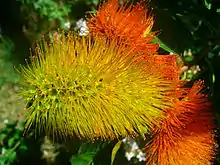
_(5629409394).jpg.webp)



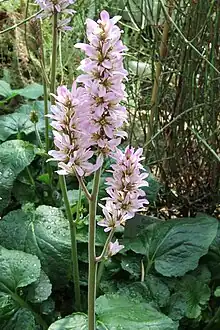


.jpg.webp)





.jpg.webp)
_in_Hyderabad%252C_AP_W_IMG_9597.jpg.webp)
.jpg.webp)
.jpg.webp)


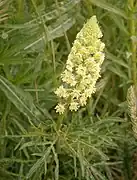




_-_Fruit_and_Spice_Park_-_Homestead%252C_Florida_-_DSC08950.jpg.webp)


_(Strasburgeriaceae)_%C2%A9_W._Barthlott%252C_Lotus-Salvinia.de%252C_(4-1991).jpg.webp)
